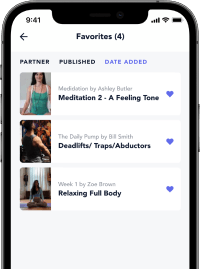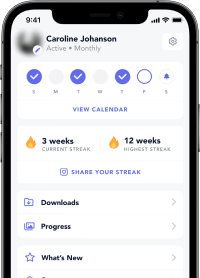
The Cut
Shredding with Sara Garavuso
12 Week Gym Based Program
The 12 weeks will be broken down into 2 six week phases that include 2 deload weeks. Throughout the 12 weeks we will be implementing cardio protocols to increase steps weekly. These cardio protocols... more

ONLY AVAILABLE ON THE PLAYBOOK APP
Sessions (10)
+5 sessions more
Frequently Asked Questions
How to get the best outcome from the program?
As the weeks go by we want to focus on progressive overload (when you gradually increase the weight, frequency, or number of repetitions in your strength training routine). It’s important to remember if we are not challenging ourselves by creating progression in our program week by week we will hit a plateau.
Ex. First week you deadlift 135lbs for 5 reps. The following week we would either add 5-10lbs and go for the same amount of reps or we can keep the weight the same but aim for 6-8 reps. Remember adding 5-10lbs in a lower body movement or compound lift is feasible - but for a woman with an upper body movement like bicep curls adding more reps at the same weight or adding 2.5lbs would be a great progression.
Two important factors on top of strength training:
- key is to increase steps/cardio weekly.
- over the 12 weeks calorie intake must be decreasing
How to schedule the program into a week?
This program breaks down the week with 5 workouts and 2 rest days. I recommend spreading your rest days out and not take them consistently. That way you are able to give your time to rest and recover.
* do not complete your cardio sessions prior to your training lifting sessions. I highly recommend completing cardio after your lifting session or as an active rest day.
Note: stepper can be substituted with walking incline on a treadmill, outdoor walking bike etc. The goal is increasing steps throughout the 12 week program.
What do I need to participate in this program?
Since this is a gym based program, you will need access to a gym. Each workout has a mixture of movements using free weights (including barbells, weight plates & DBs) and cable machines.
I recommend having a personal barbell pad you bring on your lower body days. (Most gyms have these pads available or you can use a folded yoga mat. I just prefer having my own: so I know no one else is using it and the thickness in the padding is not worn down). I also recommend keeping a weight journal to track all of your weights for each rep/set and progressions.
Who are these workouts for (skill-level)?
Beginner/intermediate/advanced
- we are sticking to the basics! So how you push yourself with the weight being used will increase the difficulty. Remember the basics are most important and will produce the outcomes we are looking for.
**difficulty comes from how you push yourself. If something feels too easy its because you are making it easy. So in this case increase the weight!!!
What are the goals of the program?
We have built a foundation of strength & muscle, now it's time to peel away to laters. Throughout this program our goal is to loose fat while we maintain strength and muscle as much as possible. In order to achieve this we want to go into a slight caloric deficit, while SLOWLY increasing our intensity of training and cardio.
We will keep a consistent routine/program focused on:
-Using progressive overload weekly to challenge yourself, maintain strength and optimize lean muscle growth
-Focusing on mind to muscle connection
-Slow and controlled movements
-Prioritizing correct form
-Tracking the weight used for each movement so we can challenge our selves weekly
- Increase steps/cardio weekly
- Decrease caloric intake as the 12 weeks progress
*Key note: Crazy and different workouts that change workout to workout or week to week will not produce the changes you are looking for. Focus on producing a solid foundation with your lifts.
Macro Terms
Carbs are important in your diet. Your body uses these foods to make glucose, which is your body's main energy source. Carbohydrates should make up anywhere from 45-50% of your daily Calories. (1g of carbs = 4 calories)
Proteins are one of the most essential macronutrients that you should include in your diet. Your protein intake should be around 20-30% of your daily calories. (1g of protein = 4 calories)
Fats should make up anywhere from 25-35% of your daily calories. We need to be thinking about healthy fats. (1g of fats = 9 calories)
Calorie: A unit of food energy.
Maintenance calories: The total amount of calories that is required daily to maintain your body weight.
Caloric deficit: the number of calories you need to consume to lose weight & body fat.
Caloric Surplus: the number of calories you need
How to go into a deficit?
*Read through the Nutrition Guide*I provide all the information and tips/tricks to calculate macros.
*** Please note if you have been eating way below your maintenance calories ( the number of calories your body needs to support energy expenditure / maintain your body weight) you SHOULD NOT be going further into a deficit. Your goal would instead be to start a reverse diet to slowly increase calories over time. Once you have given your body time to adjust at maintenance calories then you could begin a deficit.
If your body is ready to begin a deficit:
- To determine your maintenance calories, multiply your body weight (in pounds) by 12-17 depending on your activity level
12-13 for inactive or light activity
14-15 for moderate activity
16-17 for high activity
Setting Protein:
In order to maintain or increase muscle mass, protein should range between .8-1.2 grams of protein per 1lb of body weight. EX: 150lb x 1g protein = 150g of protein
Setting Fats and carbs:
First subtract the calories from protein from maintenance calories. Now we want to split the remaining calories between the fats and carbs. EX: daily caloric intake 2,000
150 g of protein = 150 x (4) = 600 calories from protein
So you would have 1,400 calories remaining to split between fats and carbohydrates. A good place to start : 45% fat and 55% carbohydrates.
Once you have calculated your maintenance, adjust your daily calorie goal by subtracting (deficit) or adding (surplus) 300-500kcal to your maintenance calorie level depending on your goal.
Weight loss = subtract
Weight gain = add
For weight loss: .5lbs-1.5lbs loss per week is ideal / sustainable for longevity
Throughout the program you'll want to drop calories SLOWLY overtime and not all at once. I like to start the first 6 weeks off by subtracting 300Kcals. Then an additional 200 the last 6 weeks, to be sure we are maintaining strength and lean mass throughout the coming weeks.
What are the types of cardio I can do during this program?
LISS (low intensity steady state) : moving at a steady pace and it’s at low intensity.
-This should feel like work but not leave you feeling destroyed.
- I will add the cardio in the weekly workouts. Examples are incline treadmill walking, bicycle, elptical, and stair stepper. However you are not limited to these choices. I want you to choose a type of cardio that you know you will be able to stick to. If you prefer HIIT, I recommend to complete those as an active rest day.
* do not complete your cardio sessions prior to your training lifting sessions. I highly recommend completing cardio after your lifting session or as an active rest day.
Note: stepper can be substituted with walking incline on a treadmill, outdoor walking bike etc. The goal is increasing steps throughout the 12 week program.
Frequently Asked Questions
How to get the best outcome from the program?
As the weeks go by we want to focus on progressive overload (when you gradually increase the weight, frequency, or number of repetitions in your strength training routine). It’s important to remember if we are not challenging ourselves by creating progression in our program week by week we will hit a plateau.
Ex. First week you deadlift 135lbs for 5 reps. The following week we would either add 5-10lbs and go for the same amount of reps or we can keep the weight the same but aim for 6-8 reps. Remember adding 5-10lbs in a lower body movement or compound lift is feasible - but for a woman with an upper body movement like bicep curls adding more reps at the same weight or adding 2.5lbs would be a great progression.
Two important factors on top of strength training:
- key is to increase steps/cardio weekly.
- over the 12 weeks calorie intake must be decreasing
How to schedule the program into a week?
This program breaks down the week with 5 workouts and 2 rest days. I recommend spreading your rest days out and not take them consistently. That way you are able to give your time to rest and recover.
* do not complete your cardio sessions prior to your training lifting sessions. I highly recommend completing cardio after your lifting session or as an active rest day.
Note: stepper can be substituted with walking incline on a treadmill, outdoor walking bike etc. The goal is increasing steps throughout the 12 week program.
What do I need to participate in this program?
Since this is a gym based program, you will need access to a gym. Each workout has a mixture of movements using free weights (including barbells, weight plates & DBs) and cable machines.
I recommend having a personal barbell pad you bring on your lower body days. (Most gyms have these pads available or you can use a folded yoga mat. I just prefer having my own: so I know no one else is using it and the thickness in the padding is not worn down). I also recommend keeping a weight journal to track all of your weights for each rep/set and progressions.
Who are these workouts for (skill-level)?
Beginner/intermediate/advanced
- we are sticking to the basics! So how you push yourself with the weight being used will increase the difficulty. Remember the basics are most important and will produce the outcomes we are looking for.
**difficulty comes from how you push yourself. If something feels too easy its because you are making it easy. So in this case increase the weight!!!
What are the goals of the program?
We have built a foundation of strength & muscle, now it's time to peel away to laters. Throughout this program our goal is to loose fat while we maintain strength and muscle as much as possible. In order to achieve this we want to go into a slight caloric deficit, while SLOWLY increasing our intensity of training and cardio.
We will keep a consistent routine/program focused on:
-Using progressive overload weekly to challenge yourself, maintain strength and optimize lean muscle growth
-Focusing on mind to muscle connection
-Slow and controlled movements
-Prioritizing correct form
-Tracking the weight used for each movement so we can challenge our selves weekly
- Increase steps/cardio weekly
- Decrease caloric intake as the 12 weeks progress
*Key note: Crazy and different workouts that change workout to workout or week to week will not produce the changes you are looking for. Focus on producing a solid foundation with your lifts.
Macro Terms
Carbs are important in your diet. Your body uses these foods to make glucose, which is your body's main energy source. Carbohydrates should make up anywhere from 45-50% of your daily Calories. (1g of carbs = 4 calories)
Proteins are one of the most essential macronutrients that you should include in your diet. Your protein intake should be around 20-30% of your daily calories. (1g of protein = 4 calories)
Fats should make up anywhere from 25-35% of your daily calories. We need to be thinking about healthy fats. (1g of fats = 9 calories)
Calorie: A unit of food energy.
Maintenance calories: The total amount of calories that is required daily to maintain your body weight.
Caloric deficit: the number of calories you need to consume to lose weight & body fat.
Caloric Surplus: the number of calories you need
How to go into a deficit?
*Read through the Nutrition Guide*I provide all the information and tips/tricks to calculate macros.
*** Please note if you have been eating way below your maintenance calories ( the number of calories your body needs to support energy expenditure / maintain your body weight) you SHOULD NOT be going further into a deficit. Your goal would instead be to start a reverse diet to slowly increase calories over time. Once you have given your body time to adjust at maintenance calories then you could begin a deficit.
If your body is ready to begin a deficit:
- To determine your maintenance calories, multiply your body weight (in pounds) by 12-17 depending on your activity level
12-13 for inactive or light activity
14-15 for moderate activity
16-17 for high activity
Setting Protein:
In order to maintain or increase muscle mass, protein should range between .8-1.2 grams of protein per 1lb of body weight. EX: 150lb x 1g protein = 150g of protein
Setting Fats and carbs:
First subtract the calories from protein from maintenance calories. Now we want to split the remaining calories between the fats and carbs. EX: daily caloric intake 2,000
150 g of protein = 150 x (4) = 600 calories from protein
So you would have 1,400 calories remaining to split between fats and carbohydrates. A good place to start : 45% fat and 55% carbohydrates.
Once you have calculated your maintenance, adjust your daily calorie goal by subtracting (deficit) or adding (surplus) 300-500kcal to your maintenance calorie level depending on your goal.
Weight loss = subtract
Weight gain = add
For weight loss: .5lbs-1.5lbs loss per week is ideal / sustainable for longevity
Throughout the program you'll want to drop calories SLOWLY overtime and not all at once. I like to start the first 6 weeks off by subtracting 300Kcals. Then an additional 200 the last 6 weeks, to be sure we are maintaining strength and lean mass throughout the coming weeks.
What are the types of cardio I can do during this program?
LISS (low intensity steady state) : moving at a steady pace and it’s at low intensity.
-This should feel like work but not leave you feeling destroyed.
- I will add the cardio in the weekly workouts. Examples are incline treadmill walking, bicycle, elptical, and stair stepper. However you are not limited to these choices. I want you to choose a type of cardio that you know you will be able to stick to. If you prefer HIIT, I recommend to complete those as an active rest day.
* do not complete your cardio sessions prior to your training lifting sessions. I highly recommend completing cardio after your lifting session or as an active rest day.
Note: stepper can be substituted with walking incline on a treadmill, outdoor walking bike etc. The goal is increasing steps throughout the 12 week program.
Features that support your success

Chat
Tell me your struggles, share your progress, request content and guidance. I'm here for you!

Favorites
Save your favorite content so it's effortless to refer back to. Build a library that serves your goals.

Streaks
Track your progress with streaks to keep yourself accountable. See how many weeks in a row you can get.

Streaming
Stream to your TV and laptop using Apple TV, Chromecast, Roku or Fire TV.

Chat
Tell me your struggles, share your progress, request content and guidance. I'm here for you!
Comments
D
Deneiva • 9mo ago
Tough one! 💪🏾
R
Ronda • 9mo ago
💀💀
R
Ramona • 9mo ago
❤️🔥🔥🔥🔥🔥🔥❤️
L
Lauren • 1y ago
So happy to be back on this workout program! Today felt gooooood!
D
Disco100 • 1y ago
Good to be back!
A
Amy • 1y ago
Oh, that good burn!
